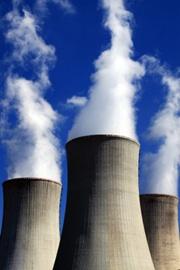 | « Back to article | Print this article |
 Proposals are being worked upon at the Copenhagen summit to cut the greenhouse gas emissions in the atmosphere, prominent among which is the use of nuclear energy.
Proposals are being worked upon at the Copenhagen summit to cut the greenhouse gas emissions in the atmosphere, prominent among which is the use of nuclear energy.
A broad scientific consensus predicts that climate change will worsen dramatically when the concentration of greenhouse gases (GHG) in the atmosphere rises above 450 parts per million.
The gasses that force climatic changes can be reduced, if the appropriate technologies are applied. For instance, power generation accounts for a third of all GHG emissions.
But, nuclear applications are powerful tools in understanding the drivers of climate change.
By recreating past climate events through nuclear reconstruction, the scientists can estimate the effect of future developments.
The IAEA (International Atomic Energy Agency) Laboratories, for instance, uses nuclear techniques and isotopes to map increasing ocean temperatures and acidification, as well as shifting ocean currents, which are growing threats for marine biodiversity and sustainability, as well as potent influences on weather and storm patterns.
Nuclear energy now supplies about 16 percent of world's electricity needs, yet is a nearly carbon-free energy source.
Nuclear energy is already reducing the impact of climate change and has in the past half-century helped to avoid as much in carbon emissions as hydropower.
Today, nuclear power plants reduce the annual global CO2 burden by two gigatonnes, or two trillion kilograms.
Over a nuclear power plant's life cycle, nuclear energy emits roughly the same amount of CO2 per unit of electricity generated as wind and hydropower, and less than renewable sources such as biomass or solar.
Significantly, it does so at an equal or lower cost per unit of electricity generated.
The IAEA helps Member States to build national capacity in conducting independent energy and environmental analysis and in developing strategic national energy plans.
This assistance involves transferring analytical and planning tools, and training national experts in their use to support the conduct of energy and electricity demand and supply studies, as well as the analysis of cost effective GHG mitigation options.
In agriculture, CO2 and other GHGs, such as nitrous oxide (N20) are also released.
The IAEA is developing and evaluating land management practices designed to capture atmospheric CO2 in soils and reduce N20 emissions to mitigate climate change, while improving crop growth.
The causes for soil degradation can be detected using environmental nuclide tracers.
The IAEA is also working to develop crop varieties able to absorb additional CO2 from the atmosphere and to utilize soil nitrogen more effectively.